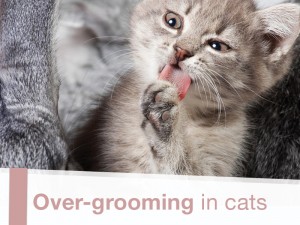
Over-grooming in cats

Grooming is part of a cat's natural behaviour and our feline companions often spend a lot of time doing it. Unfortunately there are circumstances where cats can groom themselves too much and that often indicates that there is an underlying issue that needs to be addressed.
When a cat is over-grooming it will frequently and obsessively lick, pluck or chew a given area in its body. Owners will usually notice areas with broken or with significant less hair in their coat or even with no hair at all. The most commonly affected areas are their belly, their legs, and the inside of their thighs or their back. Some cats can lick themselves to the point where they damage their own skin and bleed.
Excessive grooming in cats is usually associated with itching or pain. It's not uncommon for cats suffering from allergy to flea bites or from lower urinary tract disease to display this behaviour. It can also be related to stress and anxiety, in which case it is called feline psychogenic alopecia.
When cats feel anxious they groom themselves because they find it relaxing and comforting. Usually they will groom more frequently when they are left alone and need more reassurance.
Cats thrive on routine and they can be very sensitive to any change in their environment. Changes in the household, new pets, new family members and even if they don't get along with other cats that might also live in the same house could be a source of stress.
If you notice your cat is grooming excessively please seek veterinary assistance. Your vet will need to find what is causing the problem so he or she can recommend an adequate and effective treatment.
It is very important for the cause to be investigated in order to achieve a successful treatment so if your cat is over grooming do not hesitate to bring us your feline companion.
Would you like to know more about cats? Check our Feline Courses:
Feline courses
Read the previous article: Labour Complications in Dogs

